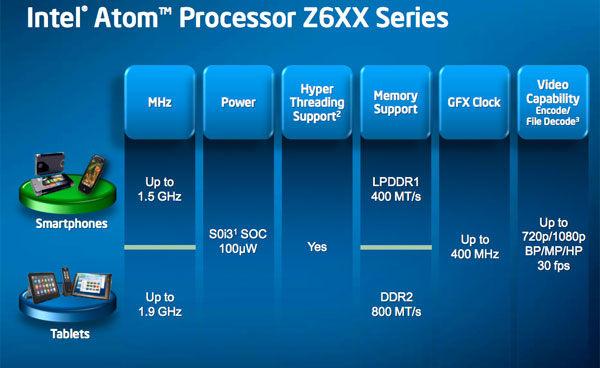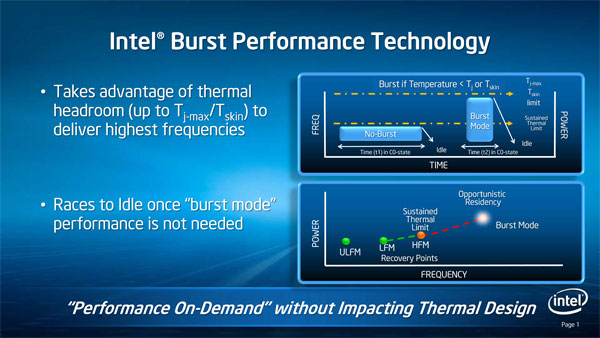Intel Unveils Moorestown and the Atom Z600, The Fastest Smartphone Platform?
by Anand Lal Shimpi on May 4, 2010 11:54 PM EST- Posted in
- Smartphones
- Intel
- Atom
- Mobile
- SoCs
Clock Speeds: 1.2GHz - 1.5GHz for Smartphones, 1.9GHz for Tablets
Intel isn't announcing individual Atom Z600 SKUs just yet, but we do know that all versions of the chip will support Hyper Threading (likely due to maintain a performance advantage compared to upcoming dual-core ARM offerings). There will be two versions of the Atom Z600 chips, one for smartphones and one for tablets.

The smartphone SKUs will run between 1.2GHz and 1.5GHz, while the tablet version of the Z600 will run at up to 1.9GHz.
Power Management: Clock Down or Turbo Up
Eleven years ago Intel demoed a technology it called Geyserville for mobile CPUs. The technology simply ran the CPU at a lower frequency when running on battery power and a higher frequency when plugged in. Intel eventually called this SpeedStep.
Four years later we got EIST, Enhanced Intel SpeedStep Technology. This allowed a mobile (and eventually desktop) CPU to run at any frequency depending on the performance demanded by the OS and the running applications.
On today’s Atom processors this usually means the chip will run as low as 600MHz when idle and at 133MHz increments all the way up to 1.66GHz under load. You don’t normally drop below 600MHz because that falls into the inefficient range of CPU performance scaling for a netbook/nettop. In a smartphone though, the majority of time your CPU isn’t being used. The SoC and accessory processors have enough custom logic offload a lot, even when your phone isn’t idle.
Lincroft, or the Atom Z600 series, supports even lower frequency modes. The CPU can clock itself down well below 600MHz.
When you need performance however Lincroft has something similar to Turbo Boost on Intel’s desktop CPUs. On the Atom Z600 series it’s called Burst Mode and unlike Turbo, it is more tightly integrated with the OS.

EIST and other dynamic clocking technologies rely on OS P-states to determine what frequency the chip should run at. If an OS requests P0, the CPU simply runs at its highest frequency.
On the Core i5 and i7, if the OS requests the CPU be in P0, then as long as the chip doesn’t violate any current or TDP limitations it will run at a higher turbo frequency instead of the default maximum clock speed the OS is requesting. P0 will always return the highest possible frequency given the thermal conditions of the chip.
The Atom Z600 doesn’t work like this. All potential burst mode frequencies are enumerated as P-states by the BIOS. An OS with proper support for Moorestown will be able to request any specific clock frequency, even burst frequencies. Loading a web page for example might result in the OS asking for the highest possible burst mode frequency, but while you’re reading the page the OS might request a slower P-state. The chip will run at whatever the OS requests, but it will exit burst mode if the chip’s temperature gets too high.
The FSB speed also scales with clock frequency. Once you reach a certain clock speed threshold, the Atom Z600 will automatically double its FSB frequency to help feed the CPU faster. The goal isn’t just to deliver peak performance, but it’s also to complete tasks faster so that the SoC can return to an idle state as soon as possible. The hurry up and go idle approach to mobile CPU performance has been one of Intel’s basic tenants for well over a decade now. And it does work. This is the reason we’ve generally seen an increase in battery life from each subsequent version of the Centrino platform.
The software management of burst mode puts more emphasis on the OS and platform vendors to properly tune their devices for the best balance of performance/power consumption. You can see why Wind River’s Android platform and Moblin are necessary to get the most out of Moorestown.










67 Comments
View All Comments
Suhail_kapoor - Wednesday, May 5, 2010 - link
Anand, Intel said 3 out of 5, you said one magic device, I think they have one sorted out ... NOKIA is a company needing revolution and this partnership is Nokia's hope for smart phone market.Also outside US and to some extent Europe Nokia has a very strong foot hold, combined with essentially free software such as MeeGo the road looks good, only IF and a big if, they can deliver on software front.
WaltFrench - Sunday, May 9, 2010 - link
“…NOKIA is a company needing revolution and this partnership is Nokia's hope for smart phone market.”Only problem: Nokia needs a polished solution fast—its average sales price is imploding and the shareholders are restless. A solution that would require them to throw away all the development work to date would be suicidal.
If it takes 12-24 months to implement a totally new architecture, with new software (seems a bit optimistic), only a smartphone maker whose roadmap is in great shape today can afford to make the switch; that'd be Apple. But they have just bulked up with PA Semi and Intrinsity; it'd be hard to imagine much Intel Inside.
Not to mention that Intel's i-series CPUs seem to have been designed to derail Apple's plans of running with a graphics-centric, well-supported CPU. The extra silicon & design time seems to have kept the i3 out of Apple's 13" notebook, while the 15" and 17" have just-a-bit-rocky auto-switch technology to fire up the NVidia GPUs. It doesn't seem that Intel has exactly been courting Apple's product intentions of late.
Lord Banshee - Wednesday, May 5, 2010 - link
Intel First SoC based on Atom is not Moorestown, but CE4100(codename Sodaville) is: http://download.intel.com/design/celect/prodbrf/32...http://intelconsumerelectronics.com/
Where is the love for Intel's CE product. Anand you should look into reviewing some products based off these products too.
ganeshts - Wednesday, May 5, 2010 - link
Sure, is there a shipping product based on the CE3xxxx or CE4xxxx series?I remember there seemed to be something like the Yuixxx from Conceptronix or some similarly named Dutch company.. Did they ever ship?
Lord Banshee - Wednesday, May 5, 2010 - link
I am not sure what products have CE products in it... CE devices typically don't advertise this kind of info.Lots of rumors when searching for ce4100 on engadget
http://www.engadget.com/search/?q=ce4100&invoc...
ganeshts - Wednesday, May 5, 2010 - link
Most of those CE4100 results are Intel announcements announcing platform updates or availabilities.The TiVo Premier result, I am not sure why it is even there.... TiVo Premier teardown revealed it is fully Boradcom based, IIRC.
I am very interested to know whether there are any CE4100 products out in the hands of the customers right now... Any Intel employees / PR guys care to offer this information?
zdzichu - Wednesday, May 5, 2010 - link
Seeing that GPU part is descendant of Paulsbo... I foresee similar fiasco with opensource drivers as with GMA500. Too bad, it really damages Intel reputation.beginner99 - Wednesday, May 5, 2010 - link
funny gma 600. Even if intel like improves gm drivers 100x fold, they will still suck...So you can pretty much say it depends on that.And there go my dreams for useful drivers for my menlow device...it's a PITA. slowing hardware by deliberatley? making horrible drivers.
JumpingJack - Wednesday, May 5, 2010 - link
Intel's graphics performance as they begin integrating into the CPU improved significantly, to the point of competitive. http://www.anandtech.com/show/2952/2Your view point is strictly from a desktop running pixels number as high as 1900x1200 (too much for even the best IGP from nVidia or ATi/AMD), on a smartpone the graphic intensity is not nearly enough... it does not need to win on the highest FPS, it just needs to get 30 FPS or better for a fluid experience.
The graphics component should be fine, no real reason to suspect otherwise.
rahvin - Wednesday, May 5, 2010 - link
Given the abysmal Linux support of the GMA500 I foresee a complete piece of crap again that will result in this being used in NO android phones. For me Android is the future of the cellphone and frankly what happened with Paulsbro foreshadows the complete crap that this platform will be on Android and other Linux based platforms (like WebOS). The concerns of the OP are completely justified and I had exactly the same reaction when I read the GPU is based on PowerVR like the piece of crap GMA500.Intel cannot succeed in the Phone space if Linux is treated with the same disdain they presented with GMA500.